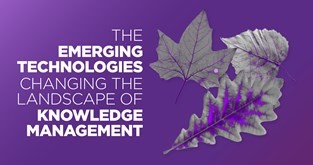The emerging technologies changing the landscape of knowledge management
At the same time that the very nature of work and business have shifted, knowledge management (KM) technologies have taken a massive leap forward. Concepts and ideas that have been in the field for years are finally realities, ready to be implemented at scale for large and complex organizations across the globe. KM experts and founders of Enterprise Knowledge, Zach Wahl and Joe Hilger, discuss these in more detail below.
Complementing the array of core KM tools, including enterprise search, content and document management, collaboration suites, and learning management systems, three types of technologies have emerged that are having a massive impact on the field.
Taxonomy Management Systems

These used to be systems of record for the taxonomies of an organization, offering a way for people within the organization to share and manage taxonomies and then replicate those taxonomies into the systems that could use them. These tools helped organizations break down silos by categorizing information in a consistent fashion. The new iterations of these systems play a much larger role in enterprise information management, using machine learning and cutting-edge AI formulas to auto-tag content. As content doubles every year, it is not possible to manually tag and categorize content, and auto-tagging allows organizations to categorize hundreds of thousands of pieces of content and keep up with the pace of content creation.
In addition to auto-tagging, the leading Taxonomy Management Systems now support ontologies. While taxonomies help organizations categorize information, ontologies provide context by defining what things are and how they relate to one another. When used with auto-tagging capabilities, these tools are now able to identify relationships between content based on the people, places, and things within the content. This new approach simplifies the way people discover information and allows machines to identify relationships that could not have been done manually.
Graph databases
Graph databases capture information about how things relate to one another. Simple graph databases have been around for over thirty years, but new versions are faster and provide better integration capabilities. However, the main change in graph databases has to do with our new understanding of what can be done with them.
Google popularized the power of graph databases with their knowledge panels, and information thought leaders in every industry found new ways to use graph databases. Graph databases now power recommendation engines through a concept called explainable AI. The graph identifies relationships that were not inherently obvious using inference: when two things can be related based on the similarity of things they are related to. For example, two board games could have very different topics, but the methods of play could be similar. The graph would identify that their methods of play had similarities and would be able to recommend one game when the buyer purchases the other game.
Another powerful feature of graph databases is the way in which they map information. Large enterprises constantly struggle with how to integrate highly disparate pieces of information. Graph databases map the information between systems so that it can be brought together into a single, holistic view for the knowledge workers in an organization. Graph databases and the new way we use them are changing the way organizations manage and assemble information for business leaders, customers, and employees.
Data Catalogs
Data Catalogs capture metadata to describe and manage an organization's data assets. This includes descriptive metadata to help find documents, social metadata about the data assets, and data lineage to track changes to the data. Five years ago, everyone was trying to handle big data needs and build central repositories to store their data (Data Lakes). However, organizations soon realized that having data in one place was not enough. In order to work with the massive amounts of data that we have today, business users need metadata that makes the data findable. Data Catalogs are a perfect complement to the investments organizations made in Data Lakes.
The Data Lake ensures that the content is managed and controlled. The Catalog ensures that it is findable and allows business users to trust the data and information they are working with. Because of the vast amount of data that organizations now work with, the Catalogs have a number of automated ways to collect and apply metadata to data assets. In addition, these tools have added social tools like discussion forums so that business users can better collaborate about the data they work with. Data Catalogs are now perfectly positioned as the entry point to all of the data assets across an enterprise.
About our guest contributors and their book
Joe Hilger and Zach Wahl founded Enterprise Knowledge (EK) in 2013 and presently serve as COO and CEO respectively. EK has been listed on the Inc. 5000 List of Fastest Growing Companies in the US every year from 2018 to 2021. EK is now the world’s largest dedicated knowledge management consultancy, having won a myriad of awards not just for its leadership in the KM field, but also as a best place to work in the region and across the United States.
Making Knowledge Management Clickable

This book bridges the gap between knowledge management and technology. It embraces the complete life-cycle of knowledge, information, and data from how knowledge flows through an organization to how end users want to handle it and experience it. Whether your intent is to design and implement a single technology or a complete collection of KM systems, this book provides the foundations necessary for success. It will help you understand your organization’s needs and opportunities, strategize and prioritize features and functions, design with the end user in mind, and finally build a system that your users will embrace and which will realize meaningful business value for your organization.
“Compelling reading for KM practitioners looking to ensure their technology decisions support their business and organizational objectives.” - Margot Brown, Director of Knowledge Management, World Bank Group
"We are two years into our KM Transformation and if I’d had this book beforehand, it would have made the journey smoother and faster! This is a great playbook for how to plan, organize, and execute a KM transformation." - Stephanie Hill, Senior Director, Global Customer Services, PayPal





